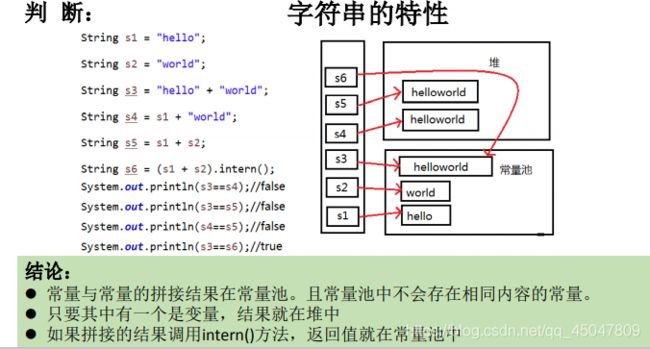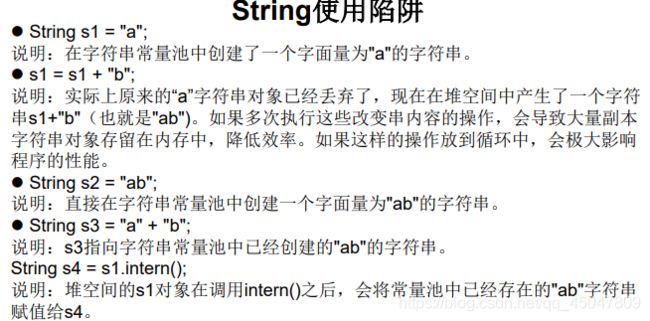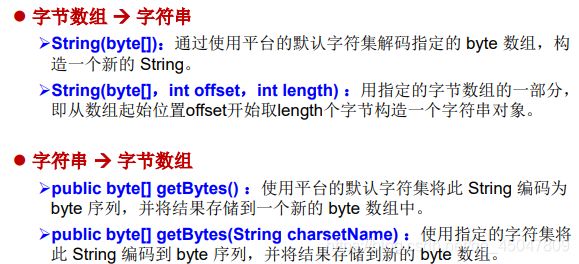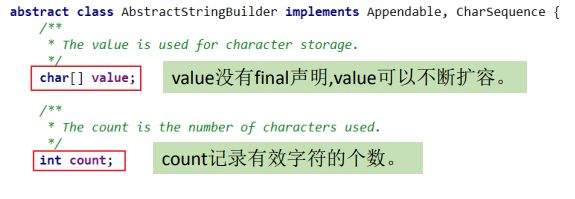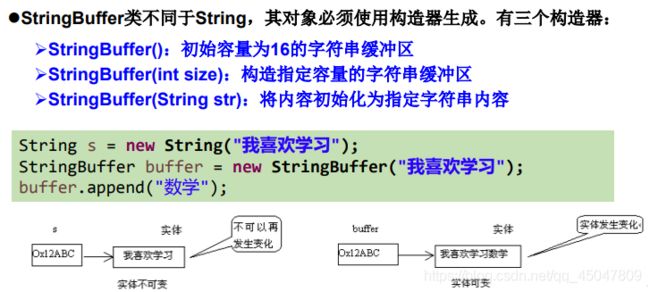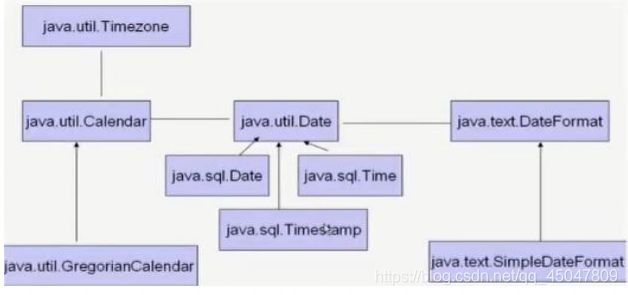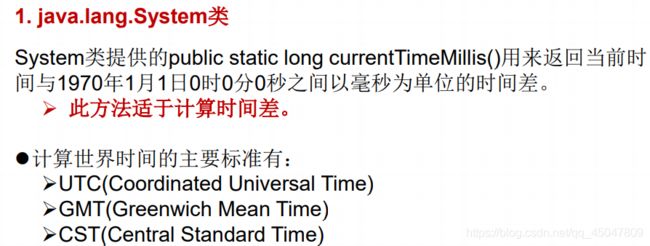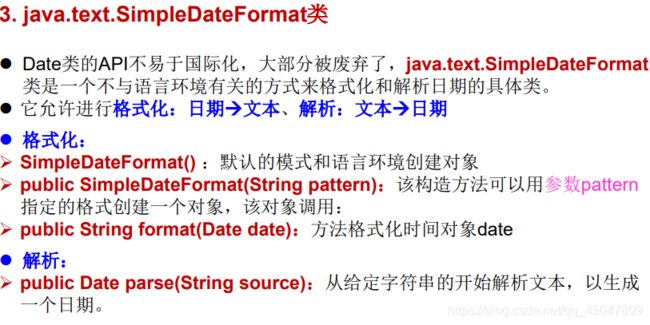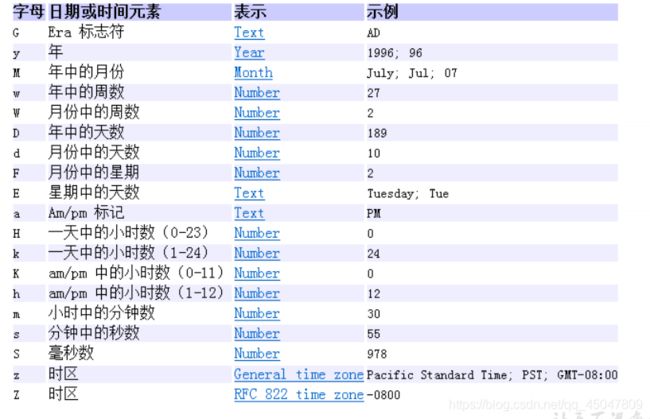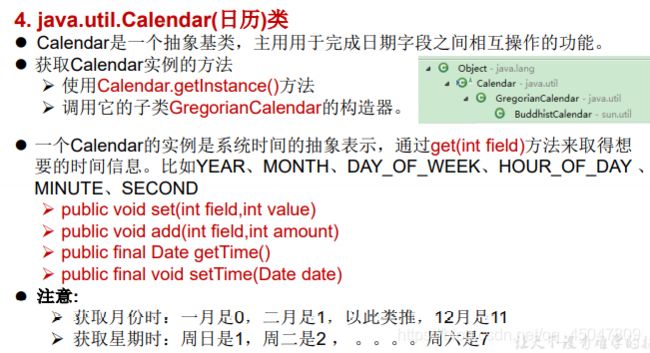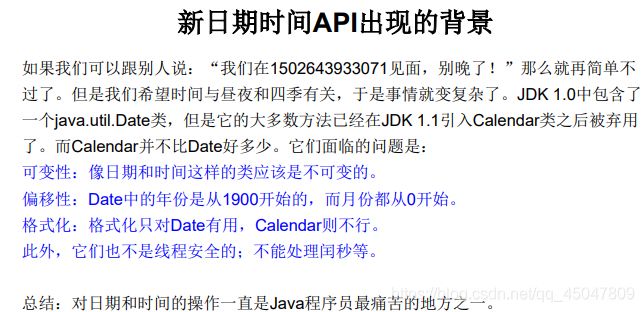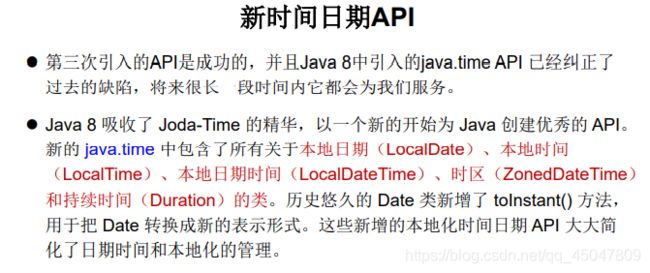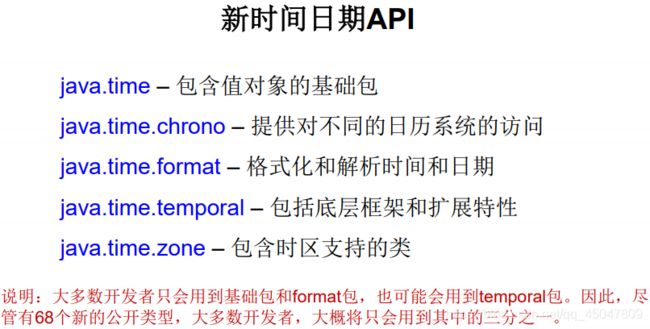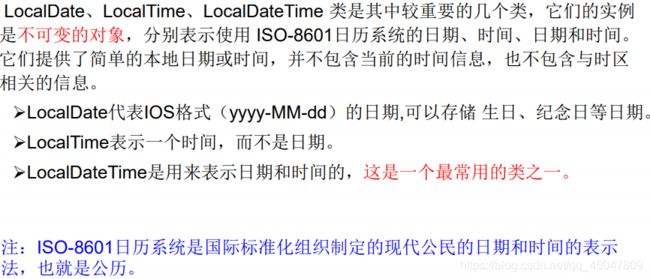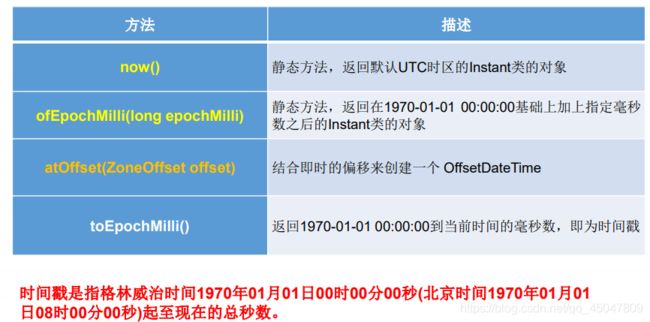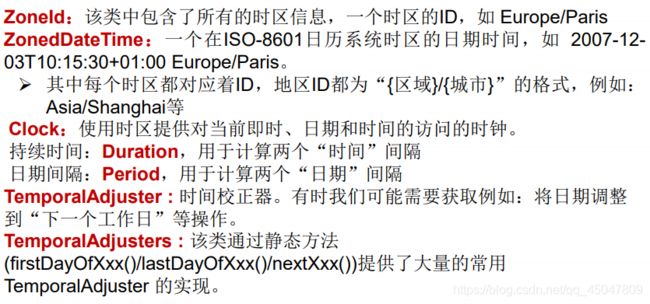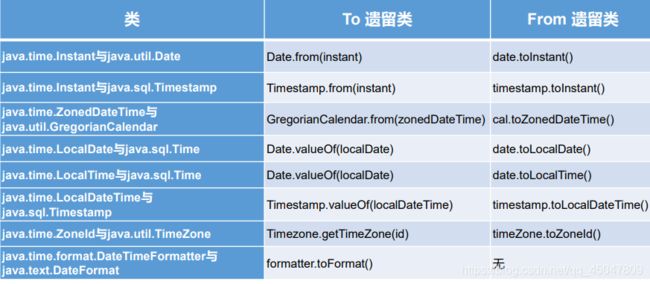java 中常用的类(笔记 十六)
目录
- 一、 字符串相关的类
-
- 1、创建字符串
- 2、String常用方法
- 3、StringBuffer
-
- StringBuffer类的常用方法
- 4、StringBuilder
- 二、JDK 8之前的日期时间API
-
- 1、System
- 2、Date类
- 3、SimpleDateFormat
- 4、Calendar
- 三、JDK8中新日期时间API
-
- 1、新日期时间API出现的背景
- 2、LocalDate、LocalTime、LocalDateTime
- 3、 瞬时:Instant
- 4、格式化与解析日期或时间 DateTimeFormatter
- 5、其它API
- 6、参考:与传统日期处理的转换
- 四、Java比较器
-
- comparable接口
- Comparator接口
- System类
- Math类
- BigInteger与BigDecimal
一、 字符串相关的类
1、创建字符串
public final class String
implements java.io.Serializable, Comparable<String>, CharSequence {
/** The value is used for character storage. */
private final char value[];
/** Cache the hash code for the string */
private int hash; // Default to 0

具体JDK API String 方法属性解析:https://www.runoob.com/manual/jdk11api/java.base/java/lang/String.html
- String对象的字符内容是存储在一个字符数组中的。 底层原理就是String字符串就是一个数组。
- private意味着外面无法直接获取字符数组,而且Strinq没有提供value的qet和set方法,
创建字符串最简单的方式如下:
String s1 = "abc";
在代码中遇到字符串常量时,这里的值是 “abc”",编译器会使用该值创建一个 String 对象。
和其它对象一样,可以使用关键字和构造方法来创建 String 对象。
用构造函数创建字符串:
String str1=new String(“abc”);
String 创建的字符串存储在公共池中,而 new 创建的字符串对象在堆上:
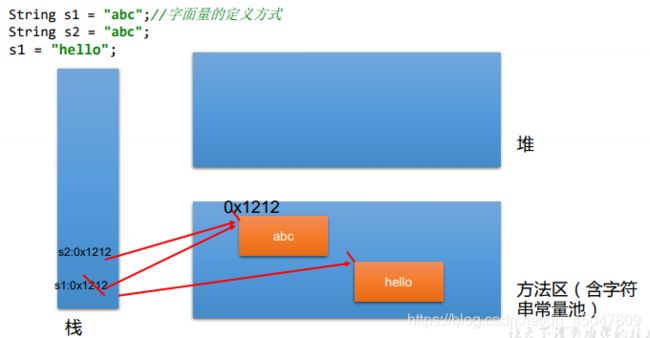

String str1 = “abc”;与String str2 = new String(“abc”);的区别?

面试题:string s = new String(“abc”);方式创建对象,在内存中创建了几个对象?
两个:一个是堆空间中new结构,另一个是char[]对应的常量池中的数据: “abc”
import org.junit.Test;
/**
* @Description: $ String 的使用
* @Author: dyq
* @Date: $
*/
public class StringTest {
/*
*结论:
1.常量与常量的拼接结果在常量池。且常量池中不会存在相同内容的常量。
* 2.只要其中有一个是变量,结果就在堆中
* 3.如果拼接的结果调用intern()方法,返回值就在常量池中
* */
@Test
public void test3() {
String s1 = "Java";
String s2 ="hello";
String s3 = "Javahello";
String s4= "Java"+"hello";
String s5 =s1+"hello";
String s6="Java"+s2;
System.out.println(s3==s4);//true
System.out.println(s3==s5);//false
System.out.println(s3==s6);//false
System.out.println(s5==s6);//false
System.out.println(s4==s6);//false
String s7 = s6.intern(); //返回值得到的s8使用的常量值中已经存在的"Javahello" intern() 返回字符串对象的规范表示。
System.out.println(s7==s3);//true
}
/*String 的实例化方式
方式一:通过字面量定义的方式
方式二:通过new+构造器的方式
* */
@Test
public void test2() {
//通过字面量定义的方式:此时的s1和s2的数据javaEE声明在方法区中的字符串常量池中。
String s1 = "javaEE";
String s2 ="javaEE";
//通过new+构造器的方式:此时的s3和s4保存的地址值,是数据在堆空间中开辟空间以后对应的地址值。
String s3 = new String("javaEE");
String s4 = new String("javaEE");
System.out.println(s1==s2); //true
System.out.println(s3==s4); //false
}
/*String字符串,使用一对""引起来表示
1,String声明为final的,不可被继承
2,String实现Serializable接口:表示字符串是支持序列化的。
实现Comparable接口:表示String可以比较大小。
3.String内部定义了final char[] value 用于存储字符串数据
4.String:代表不可变的字符序列,简称:不可变性
体现:1,当对字符串重新赋值时,需要重写指定内存区域赋值,不能使用原有的value进行赋值
2,当对现有的字符串进行连接操作时,也需要重新指定内存区域赋值,不能使用原有的value进行赋值
3.当调用string的replace()方法修改指定字符或字符串时,也需要重新指定内存区域赋值,原有的value进行赋值
5.通过字面量的方式(区别于new)给一个字符串赋值,此时的字符串值声明在字符串常量池中。
6.字符串常量池中是不会存储相同内容的字符串的。
* */
@Test
public void test1(){
String s1 = "abc"; //字面量的定义方式
String s2 = "abc";
s1 = "hello";
System.out.println(s1);//hello
System.out.println(s2);//abc
System.out.println(s1.equals(s2)); //比较s1和s2的地址值 flase
System.out.println("*********************");
s1 += "diaolove";
System.out.println(s1); //hellodiaolove
System.out.println("*********************");
String s4 = "abc";
String s5 = s4.replace('a', 'b'); // replace是返回从替换所有出现的导致一个字符串 oldChar在此字符串 newChar 。
System.out.println(s5); //bbc
int len = s1.length();
System.out.println("字符串的长度为" + len);
int hash = s1.hashCode();
System.out.println(hash);
}
}
一道面试题:
public class StringTest1 {
String str = new String("good");
char[] ch = {
't', 'e', 's', 't' };
public void change(String str, char ch[]) {
str = "test ok";
ch[0] = 'b';
}
public static void main(String[] args) {
StringTest1 ex = new StringTest1();
ex.change(ex.str, ex.ch);
System.out.print(ex.str + " and ");//good
System.out.println(ex.ch); //best
}
}
2、String常用方法
| 方法 | 解析 |
|---|---|
| int length(): | 返回字符串的长度: return value.length |
| char charAt(int index): | 返回某索引处的字符return value[index] |
| boolean isEmpty(): | 判断是否是空字符串:return value.length == 0 |
| String toLowerCase(): | 使用默认语言环境,将 String 中的所有字符转换为小写 |
| String toUpperCase(): | 使用默认语言环境,将 String 中的所有字符转换为大写 |
| String trim(): | 返回字符串的副本,忽略前导空白和尾部空白 |
| boolean equals(Object obj): | 比较字符串的内容是否相同 |
| boolean equalsIgnoreCase(String anotherString): | 与equals方法类似,忽略大小写 |
| String concat(String str): | 将指定字符串连接到此字符串的结尾。 等价于用“+” |
| int compareTo(String anotherString): | 比较两个字符串的大小 |
| String substring(int beginIndex): | 返回一个新的字符串,它是此字符串的从 beginIndex开始截取到最后的一个子字符串。 |
| String substring(int beginIndex, int endIndex) : | 返回一个新字符串,它是此字符串从beginIndex开始截取到endIndex(不包含)的一个子字符串。 |
| boolean endsWith(String suffix): | 测试此字符串是否以指定的后缀结束 |
| boolean startsWith(String prefix): | 测试此字符串是否以指定的前缀开始 |
| boolean startsWith(String prefix, int toffset): | 测试此字符串从指定索引开始的子字符串是否以指定前缀开始 |
| boolean contains(CharSequence s): | 当且仅当此字符串包含指定的 char 值序列时,返回 true |
| int indexOf(String str): | 返回指定子字符串在此字符串中第一次出现处的索引 |
| int indexOf(String str, int fromIndex): | 返回指定子字符串在此字符串中第一次出现处的索引,从指定的索引开始 |
| int lastIndexOf(String str): | 返回指定子字符串在此字符串中最右边出现处的索引 |
| int lastIndexOf(String str, int fromIndex): | 返回指定子字符串在此字符串中最后一次出现处的索引,从指定的索引开始反向搜索注意:indexOf和lastIndexOf方法如果未找到都是返回-1 |
| String replace(char oldChar, char newChar): | 返回一个新的字符串,它是通过用 newChar 替换此字符串中出现的所有 oldChar 得到的。 |
| String replace(CharSequence target, CharSequence replacement): | 使用指定的字面值替换序列替换此字符串所有匹配字面值目标序列的子字符串。 |
| String replaceAll(String regex, String replacement) : | 使 用 给 定 的replacement 替换此字符串所有匹配给定的正则表达式的子字符串。 |
| String replaceFirst(String regex, String replacement) : | 使 用 给 定 的replacement 替换此字符串匹配给定的正则表达式的第一个子字符串。 |
| boolean matches(String regex): | 告知此字符串是否匹配给定的正则表达式。 |
| String[] split(String regex): | 根据给定正则表达式的匹配拆分此字符串。 |
| String[] split(String regex, int limit): | 根据匹配给定的正则表达式来拆分此字符串,最多不超过limit个,如果超过了,剩下的全部都放到最后一个元素中。 |
public class StringTest3 {
public static void main(String[] args) {
String str = "12hello34world5java7891mysql456";
//把字符串中的数字替换成,,如果结果中开头和结尾有,的话去掉
String string = str.replaceAll("\\d+", ",").replaceAll("^,|,$", "");
System.out.println(string); //hello,world,java,mysql
String str1 = "12345";
//判断str字符串中是否全部有数字组成,即有1-n个数字组成
boolean matches = str1.matches("\\d+");
System.out.println(matches); //true
String tel = "0571-4534289";
//判断这是否是一个杭州的固定电话
boolean result = tel.matches("0571-\\d{7,8}");
System.out.println(result);//true
String str2 = "hello|world|java";
String[] strs = str2.split("\\|");
for (int i = 0; i < strs.length; i++) {
System.out.println(strs[i]);
/*
* hello
world
java*/
}
System.out.println();
String str3 = "hello.world.java";
String[] strs3 = str3.split("\\.");
for (int i = 0; i < strs3.length; i++) {
System.out.println(strs3[i]);
// hello
//world
//java
}
}
}
正则表达式扩展:正则表达式
String类与其他结构之间的转换
import java.io.UnsupportedEncodingException;
import java.util.Arrays;
/**
* @Description: $ 涉及到String类与其他之间的转换
* @Author: dyq
* @Date: $
*/
public class StringTest4 {
public static void main(String[] args) throws UnsupportedEncodingException {
// String与基本数据类型,包装类型之间的转换
// String -->基本数据类型、包装类;调用包装类的静态方法: parsexxx(str)
// 基本数据类型、包装类-->String:调用String重载的valueof(xxx)
String st1 ="123";
int num = Integer.parseInt(st1); //string 转 int
String st2 = String.valueOf(num); //int 转 string
// String 与char[]之间的转换
String s = "abc123";
char[] chars = s.toCharArray();
for (int i =0;i<chars.length;i++){
System.out.print(chars[i]+"\t");
}
char[] arr = new char[]{
'h','e','l','l','o'};
String s1 = new String(arr);
System.out.println(s1);
// String 与byte[]之间的转换
// 编码:String --> byte[]:调用String的igetBytes()
// 解码: byte[--> string:调用String的构造器
// 编码:字符串-->字节(看得懂--->看不懂的二进制数据)
// 解码:编码的逆过程,字节-->字符串(看不懂的二进制数据---》看得懂)
// 说明:解码时,要求解码使用的字符集必须与编码时使用的字符集一致,否则会出现乱码。
String s2 ="javaTest爱你哟";
byte[] bytes = s2.getBytes(); //使用默认的字符集,进行转换
System.out.println(Arrays.toString(bytes));
byte[] gbks = s2.getBytes("gbk");
System.out.println(Arrays.toString(gbks));
System.out.println("*********************");
String s3 = new String(bytes); //使用默认的字符集,进行解码
System.out.println(s3);
String s4 = new String(gbks);
System.out.println(s4); //出现乱码,原因:编码集合解码集不一致!
String str4 =new String(gbks,"gbk");
System.out.println(str4);//没有出现乱码
}
}
import java.io.UnsupportedEncodingException;
import java.util.Arrays;
/**
* @Description: $ 涉及到String类与其他结构之间的转换
* @Author: dyq
* @Date: $
*/
public class StringTest4 {
public static void main(String[] args) throws UnsupportedEncodingException {
// String与基本数据类型,包装类型之间的转换
// String -->基本数据类型、包装类;调用包装类的静态方法: parsexxx(str)
// 基本数据类型、包装类-->String:调用String重载的valueof(xxx)
String st1 ="123";
int num = Integer.parseInt(st1); //string 转 int
String st2 = String.valueOf(num); //int 转 string
// String 与char[]之间的转换
String s = "abc123";
char[] chars = s.toCharArray();
for (int i =0;i<chars.length;i++){
System.out.print(chars[i]+"\t");
}
char[] arr = new char[]{
'h','e','l','l','o'};
String s1 = new String(arr);
System.out.println(s1);
// String 与byte[]之间的转换
// 编码:String --> byte[]:调用String的igetBytes()
// 解码: byte[--> string:调用String的构造器
// 编码:字符串-->字节(看得懂--->看不懂的二进制数据)
// 解码:编码的逆过程,字节-->字符串(看不懂的二进制数据---》看得懂)
// 说明:解码时,要求解码使用的字符集必须与编码时使用的字符集一致,否则会出现乱码。
String s2 ="javaTest爱你哟";
byte[] bytes = s2.getBytes(); //使用默认的字符集,进行转换
System.out.println(Arrays.toString(bytes));
byte[] gbks = s2.getBytes("gbk");
System.out.println(Arrays.toString(gbks));
System.out.println("*********************");
String s3 = new String(bytes); //使用默认的字符集,进行解码
System.out.println(s3);
String s4 = new String(gbks);
System.out.println(s4); //出现乱码,原因:编码集合解码集不一致!
String str4 =new String(gbks,"gbk");
System.out.println(str4);//没有出现乱码
}
}
3、StringBuffer
StringBuffer类的常用方法
| 方法 | 解析 |
|---|---|
| StringBuffer append(xxx): | 提供了很多的append()方法,用于进行字符串拼接 |
| StringBuffer delete(int start,int end): | 删除指定位置的内容 |
| StringBuffer replace(int start, int end, String str): | 把[start,end)位置替换为strv |
| StringBuffer insert(int offset, xxx): | 在指定位置插入xxx |
| StringBuffer reverse() : | 把当前字符序列逆转 |
4、StringBuilder
import org.junit.Test;
/**
* @Description: String. StringBuffer、 StringBuilder三者的异同?
* string:不可变的字符序列;底层使用char[]存储
* stringBuffer:可变的字符序列;线程安全的,效率低。底层使用char[]存储
* StringBuilder: 可变的字符序列;jdk5.0 新增的,线程不安全,效率高;底层使用char[]存储 $
*
* 源码分析:
* string str = new String(); // char[ ] value = new char[e];
* string str1 = new string("abc" );// char[] value = new char[]i ' a ' , 'b ' , ' c '];
*
* stringBuffer sb1 = new StringBuffer(); //char[] value = new char[16];底层创建了一个长度颊
* stringBuffer创建源码,所以声明出一个长度为16的数组。
* //public StringBuffer(String str) {
* super(str.length() + 16);
* append(str);
* }
* //
* System.out.println(sb1.length()); //0
* sb1.append( 'a'); //value[e] = 'a';
* sb1 .append( 'b');//value[1] = 'b' ;
*
* StringBuffer sb2 = new StringBuffer("abc"); //char[] value = new char[ "abc ".Length()+ 16];
*
* //问题1.System.out.println( sb2.Length());//3
*问题2.扩容问题:如果要添加的数据底层数组盛不下了,那就需要扩容底层的数组。
* 默认情况下,扩容为原来容量的2倍+2,同时将原有数组中的元素复制到新的数组中。
* private void ensureCapacityInternal(int minimumCapacity) {
* // overflow-conscious code
* if (minimumCapacity - value.length > 0) {
* value = Arrays.copyOf(value,
* newCapacity(minimumCapacity));
* }
* }
* 指导意义:开发中建议大家使用:StringBuffer(int capacity)或 StringBuiller(int capacity)
*
* 总结:
* 增: append(xxx)
* 别: delete(int start,int end)
* 改: setCharAt(int n ,char ch) / replace(int start, int end,string str)查: charAt(int n )
* 插: insert(int offset,xxx)长度: Length();
* *遍历:for() +charAt() / toString()
*
* @Author: dyq
* @Date: $
*/
public class StringBufferStringBuilder {
@Test
public void test1(){
StringBuffer stringBuffer = new StringBuffer("abc");
stringBuffer.append('o'); //字符串拼接
System.out.println(stringBuffer);//abco
stringBuffer.setCharAt(1,'p'); //字符串替换
System.out.println(stringBuffer); //apco
System.out.println(stringBuffer.length());//字符串长度 4
//substring(int start, int end)
//返回一个新的 String ,其中包含当前包含在此序列中的字符的子序列。
String a =stringBuffer.substring(1,2);
System.out.println(a); //p
stringBuffer.delete(1,2); //删除字符串
System.out.println(stringBuffer); //aco
//appendCodePoint(int codePoint)
//将 codePoint参数的字符串表示形式追加到此序列。
int str=65; //A
stringBuffer.appendCodePoint(str);
System.out.println(stringBuffer); //acoA
//public int capacity()
//返回当前容量。 容量是新插入字符可用的存储量,超出该容量将进行分配。
int b=stringBuffer.capacity();
System.out.println(b);
//将 str数组参数的子数组的字符串表示形式插入此序列中。
stringBuffer.insert(stringBuffer.length(),"啊!美女!");
System.out.println(stringBuffer); //acoA啊!美女!
//导致此字符序列被序列的反向替换。
stringBuffer.reverse();
System.out.println(stringBuffer); //!女美!啊Aoca
//从指定的索引处开始,返回指定子字符串第一次出现的字符串中的索引。
String str1 ="c";
int c= stringBuffer.indexOf(str1,0);
System.out.println(c); //7
String str2 ="a";
//返回指定索引处的char值。索引的范围是0--length()-1。
// 序列的第一个char值在索引的0处,第二个在索引1处,以此类推,这类似于数组索引。
char d= stringBuffer.charAt(7);
System.out.println(d); //c
}
//对比String. StringBuffer、 StringBuiLder三者的效率:
// 从高到低排列:StringBuilder > StringBuffer > string
@Test
public void test2(){
//初始化设置
long startTime = 0L;
long endTime = 0L;
String text = "";
StringBuffer buffer = new StringBuffer("");
StringBuilder builder = new StringBuilder("");
//开始对比
startTime = System.currentTimeMillis();
for (int i = 0; i < 20000; i++) {
buffer.append(String.valueOf(i));
}
endTime = System.currentTimeMillis();
System.out.println("StringBuffer的执行时间:" + (endTime - startTime));
startTime = System.currentTimeMillis();
for (int i = 0; i < 20000; i++) {
builder.append(String.valueOf(i));
}
endTime = System.currentTimeMillis();
System.out.println("StringBuilder的执行时间:" + (endTime - startTime));
startTime = System.currentTimeMillis();
for (int i = 0; i < 20000; i++) {
text = text + i;
}
endTime = System.currentTimeMillis();
System.out.println("String的执行时间:" + (endTime - startTime));
}
/*StringBuffer的执行时间:4
StringBuilder的执行时间:3
String的执行时间:957
* */
}
饭后甜点:
public class strTest {
public static void main(String[] args) {
String a="123";
String b ="123";
String c=new String("123");
String d = new String("123");
System.out.println(a.equals(b)); //true
System.out.println(a==b);//true 地址值一样
System.out.println(c.equals(b)); //true
System.out.println(c==d);//false 地址值不一样
System.out.println(a.equals(c));//true
System.out.println(a==c);//false 地址值不一样
}
}
与StringBuffer、StringBuilder之间的转换
String -->StringBuffer、StringBuilder:调用stringBuffer、stringBuilder构造器
StringBuffer、StringBuilder -->①String : 调用string构造器; ②StringBuffer、StringBuilder的tostring()
JVM中字符串常量池存放位置说明:
jdk 1.6 (jdk 6.e ,java 6.0):字符串常量池存储在方法区〈永久区>
jdk 1.7:字符串常量池存储在堆空间
jdk 1.8:字符串常量池存储在方法区(元空间)
二、JDK 8之前的日期时间API
1、System
2、Date类
import java.util.Date;
/**
* @Description: JDK 8之前日期和时间的AP工测试
* @Author: dyq
* @Date: $
*/
public class DateTest {
@Test
public void test1(){
long time = System.currentTimeMillis();
//返回1970年1月1日0时0分0秒之间以毫秒为单位的时间差。
System.out.println(time);
}
/*
java.util.Date类
/---java.sqLDate类
1.两个构造器的使用
2.两个方法的使用
>tostring(():显示当前的年、月、日、时、分、秒
>getTime():获取当前Date对象对应的时间戳
3. java.sql. Date对应着数据库中的日期类型的变量
>如何实例化
>如何将util.Date对象zhaur
*/
@Test
public void test2(){
//构造器一:Date():创建一个对应当前时间的Date对象
Date date = new Date();
System.out.println(date.toString()); //Wed Apr 28 11:55:31 CST 2021
System.out.println(date.toInstant()); //2021-04-28T03:55:31.164Z
System.out.println(date.getTime()); //毫秒数
//构造器二:创建指定毫秒数的Date对斜
Date date1 = new Date(161958220726L);
System.out.println(date1.toString());
//创建java。sql.Date对象
java.sql.Date date2 = new java.sql.Date(67483472943L);
System.out.println(date2); //1972-02-21
//如何将java.util.Ddte对象转换为java.sqL.Date对象
Date date3 = new java.sql.Date(67483472943L);
java.sql.Date date4 = (java.sql.Date) date3;
System.out.println(date4);
}
}
3、SimpleDateFormat
4、Calendar
import java.text.ParseException;
import java.text.SimpleDateFormat;
import java.util.Calendar;
import java.util.Date;
/**
* jdk 8之前的日期时间的AP工测试
* 1. System类中currentTimeMiLlis();
* 2. java.util.Date和子类java.sql.Date.
* 3.SimpLeDateFormat
* 4. calendar
*/
public class DateTimeTest {
@Test
public void Test() throws ParseException {
SimpleDateFormat sdf = new SimpleDateFormat();
Date date = new Date();
System.out.println("格式化前:"+date);
String format = sdf.format(date);
System.out.println("格式化后:"+format);
//解析:各耍的逆向过程,字符串---》日期
String str = "21-04-30 下午4:29"; //默认行为
Date date1 = sdf.parse(str);
System.out.println(date1);
SimpleDateFormat sdf1 = new SimpleDateFormat("yyyy-MM-dd hh:mm:ss");
String format1 = sdf1.format(date);
System.out.println(format1); //2021-04-28 04:49:00
//解析:要求字符串必须是符合SimpleDateFormat识别的格式(通过构造器参数体现)
Date parse = sdf1.parse("2021-04-28 04:49:00");
System.out.println(parse);
}
// 练习一:字符串"2020-09-08"转换为java.sqL. Date
@Test
public void testExer() throws ParseException{
String birth = "2020-09-08" ;
SimpleDateFormat sdf1 = new SimpleDateFormat( "yyyy-MM-dd" );
Date date = sdf1.parse(birth);
System.out.println(date);
java.sql.Date birthDate = new java.sql.Date(date.getTime());
System.out.println(birthDate);
}
// 练习二:“三天打渔两天晒网”1990-e1-01xXXX-XX-x×打渔?晒网?
// 举例: 2020-09-08 ?总天数
// 总天数% 5 == 1,2,3
// 打渔总天数% 5 == 4,0 :晒网
// 总天数的计算?
// 方式一:(date2.getTime( )-date1.getTime())/(1000* 60*60*24)+1
// 方式二:1990-01-01 -->2019-12-31 + 2020-01-01 -->2020-09-08
@Test
public void Test3(){
String date ="2021-09-01";
}
/*Calencar日历类的使用
* */
@Test
public void testCalendar(){
//实例化
Calendar calendar = Calendar.getInstance();
// 从一个 Calendar 对象中获取 Date 对象
Date date = calendar.getTime();
// 使用给定的 Date 设置此 Calendar 的时间
date = new Date(234234235235L);
calendar.setTime(date);
calendar.set(Calendar.DAY_OF_MONTH, 8);
System.out.println("当前时间日设置为8后,时间是:" + calendar.getTime());
calendar.add(Calendar.HOUR, 2);
System.out.println("当前时间加2小时后,时间是:" + calendar.getTime());
calendar.add(Calendar.MONTH, -2);
System.out.println("当前日期减2个月后,时间是:" + calendar.getTime());
}
}
三、JDK8中新日期时间API
1、新日期时间API出现的背景
2、LocalDate、LocalTime、LocalDateTime
3、 瞬时:Instant
代码测试:
import org.junit.Test;
import java.sql.Date;
import java.time.*;
/**
* @Description: $
* @Author: dyq
* @Date: $
*/
public class JDK8DateTimeTest {
@Test
public void TestDate(){
//偏移性:Date中的年份是从1900开始的,而月份都从0开始。
Date data = new Date(2020-1900,9-1,8);
System.out.println(data); //2020-09-08
}
// LocalDate、LocalTime、LocalDateTime
@Test
public void TestDate1(){
//now():获取当前日期,时间,日期+时间
// 说明:
//1.LocalDateTime相较于LocaLDate. LocalTime,使用频率要高
LocalDate localDate = LocalDate.now();
LocalTime localTime = LocalTime.now();
LocalDateTime localDateTime = LocalDateTime.now();
System.out.println(localDate);//2021-04-29
System.out.println(localTime);// 14:14:25.182
System.out.println(localDateTime);//2021-04-29T14:14:25.182
//of():设置指定的年,月,日,时i, 分,秒。没有偏移量
LocalDateTime localDateTime1 =LocalDateTime.of(2021,4,29,23,34,56);
System.out.println(localDateTime1);
//getXXX():获取相关的属性
System.out.println( localDateTime.getDayOfMonth());//这个月的第几天
System.out.println(localDateTime.getDayOfWeek());
System.out.println(localDateTime.getDayOfYear());
System.out.println(localDateTime.getHour());
System.out.println(localDateTime.getMinute());
//提现不可变性
//withXXX():设置相关的属性
LocalDate localDate1 = localDate.withDayOfMonth(22);
System.out.println(localDate);//2021-04-29
System.out.println(localDate1); //2021-04-22
LocalDateTime localDateTime2= localDateTime.withHour(4);
System.out.println(localDateTime); //2021-04-29T14:53:03.028
System.out.println(localDateTime2); //2021-04-29T04:53:03.028
//不可变性
LocalDateTime localDateTime3=localDateTime.plusMonths(3);
System.out.println(localDateTime); //2021-04-29T14:55:01.746
System.out.println(localDateTime3); //2021-07-29T14:55:01.746
LocalDateTime localDateTime4 = localDateTime.minusDays(6);
System.out.println(localDateTime); //2021-04-29T15:10:41.551
System.out.println(localDateTime4); //2021-04-23T15:10:41.551
}
/*
* instant的使用
类似于java.util.Date类
*/
@Test
public void tetsInstant(){
Instant instant =Instant.now();
System.out.println(instant);//2021-04-29T07:21:53.583Z
//
OffsetDateTime offsetDateTime=instant.atOffset(ZoneOffset.ofHours(8));
System.out.println(offsetDateTime); //2021-04-29T15:21:53.583+08:00
//toEpochMilli():获取自1970年1月1日0时e分e秒(UTC)开始的豪秒数
long milli=instant.toEpochMilli();
System.out.println(milli);
//ofEpochMilli( ):通过给定的毫秒数,获取Instant实例-->Date(Long millis)
Instant instant1 =Instant.ofEpochMilli(1619681113946L);
System.out.println(instant1);
}
}
4、格式化与解析日期或时间 DateTimeFormatter
5、其它API
import org.junit.Test;
import java.time.*;
import java.time.format.DateTimeFormatter;
import java.time.format.FormatStyle;
import java.time.temporal.Temporal;
import java.time.temporal.TemporalAccessor;
import java.time.temporal.TemporalAdjuster;
import java.time.temporal.TemporalAdjusters;
import java.util.Set;
/**
* @Description: $
* @Author: dyq
* @Date: $
*/
public class DateTimeFormatterTest {
@Test
public void test(){
//方式一:预定义的标准格式:
DateTimeFormatter formatter = DateTimeFormatter.ISO_LOCAL_DATE_TIME;
//格式化
LocalDateTime localDateTime=LocalDateTime.now();
String str1=formatter.format(localDateTime);
System.out.println(localDateTime); //2021-04-29T15:36:41.727
System.out.println(str1);//2021-04-29T15:36:41.727
//解析:字符串--》日期
TemporalAccessor parse= formatter.parse("2021-04-29T15:36:41.727");
System.out.println(parse);
//方式二:
// 本地化相关的格式。
// 如: ofLocalizedDateTimle( FormatStyLe.LONG)
DateTimeFormatter formatter1 =DateTimeFormatter.ofLocalizedDateTime(FormatStyle.LONG);
String str2 = formatter1.format(localDateTime);
System.out.println(str2); //2021年4月29日 下午03时46分35秒
//本地化相关的格式。如: ofLocalizedDate()
// FormatSstyle.FULL / FormatStyLe.LONG / FormatStyLe.NEDTU / FormatStyLe.SHORT:适用于lLocalDate
DateTimeFormatter formatter2 = DateTimeFormatter.ofLocalizedDate(FormatStyle.FULL);
String str3 = formatter2.format(LocalDate.now());
System.out.println(str3); //2021年4月29日 星期四
DateTimeFormatter formatter3 = DateTimeFormatter.ofLocalizedDate(FormatStyle.MEDIUM);
String str4 = formatter3.format(LocalDate.now());
System.out.println(str4); //2021年4月29日
//重点: 方式三:自定义的格式。如: ofPattern("yyyy-MM-dd hh : mm : ss E")
DateTimeFormatter formatter4 = DateTimeFormatter.ofPattern("yyyy-MM-dd hh:mm:ss");
//格式化
String str5 =formatter4.format(LocalDateTime.now());
System.out.println(str5); //2021-04-29 03:53:15
//解析
TemporalAccessor accesso= formatter4.parse("2021-04-29 03:53:15");
System.out.println(accesso);//{SecondOfMinute=15, HourOfAmPm=3, MicroOfSecond=0, MinuteOfHour=53, NanoOfSecond=0, MilliOfSecond=0},ISO resolved to 2021-04-29
}
@Test
public void Test(){
//ZoneId:类中包含了所有的时区信息
// ZoneId的getAvailableZoneIds():获取所有的ZoneId
Set<String> zoneIds = ZoneId.getAvailableZoneIds();
for (String s : zoneIds) {
System.out.println(s);
}
// ZoneId的of():获取指定时区的时间
LocalDateTime localDateTime = LocalDateTime.now(ZoneId.of("Asia/Tokyo"));
System.out.println(localDateTime);
//ZonedDateTime:带时区的日期时间
// ZonedDateTime的now():获取本时区的ZonedDateTime对象
ZonedDateTime zonedDateTime = ZonedDateTime.now();
System.out.println(zonedDateTime);
// ZonedDateTime的now(ZoneId id):获取指定时区的ZonedDateTime对象
ZonedDateTime zonedDateTime1 = ZonedDateTime.now(ZoneId.of("Asia/Tokyo"));
System.out.println(zonedDateTime1);
}
@Test
public void Test1() {
//Duration:用于计算两个“时间”间隔,以秒和纳秒为基准
LocalTime localTime = LocalTime.now();
LocalTime localTime1 = LocalTime.of(15, 23, 32);
//between():静态方法,返回Duration对象,表示两个时间的间隔
Duration duration = Duration.between(localTime1, localTime);
System.out.println(duration);
System.out.println(duration.getSeconds());
System.out.println(duration.getNano());
LocalDateTime localDateTime = LocalDateTime.of(2016, 6, 12, 15, 23, 32);
LocalDateTime localDateTime1 = LocalDateTime.of(2017, 6, 12, 15, 23, 32);
Duration duration1 = Duration.between(localDateTime1, localDateTime);
System.out.println(duration1.toDays());
}
@Test
public void Test2() {
//Period:用于计算两个“日期”间隔,以年、月、日衡量
LocalDate localDate = LocalDate.now();
LocalDate localDate1 = LocalDate.of(2028, 3, 18);
Period period = Period.between(localDate, localDate1);
System.out.println(period);
System.out.println(period.getYears());
System.out.println(period.getMonths());
System.out.println(period.getDays());
Period period1 = period.withYears(2);
System.out.println(period1);
}
@Test
public void Test3(){
// TemporalAdjuster:时间校正器
// 获取当前日期的下一个周日是哪天?
TemporalAdjuster temporalAdjuster = TemporalAdjusters.next(DayOfWeek.SUNDAY);
LocalDateTime localDateTime = LocalDateTime.now().with(temporalAdjuster);
System.out.println(localDateTime);
// 获取下一个工作日是哪天?
LocalDate localDate = LocalDate.now().with(new TemporalAdjuster() {
@Override
public Temporal adjustInto(Temporal temporal) {
LocalDate date = (LocalDate) temporal;
if (date.getDayOfWeek().equals(DayOfWeek.FRIDAY)) {
return date.plusDays(3);
} else if (date.getDayOfWeek().equals(DayOfWeek.SATURDAY)) {
return date.plusDays(2);
} else {
return date.plusDays(1);
}
}
});
System.out.println("下一个工作日是:" + localDate);
}
}

